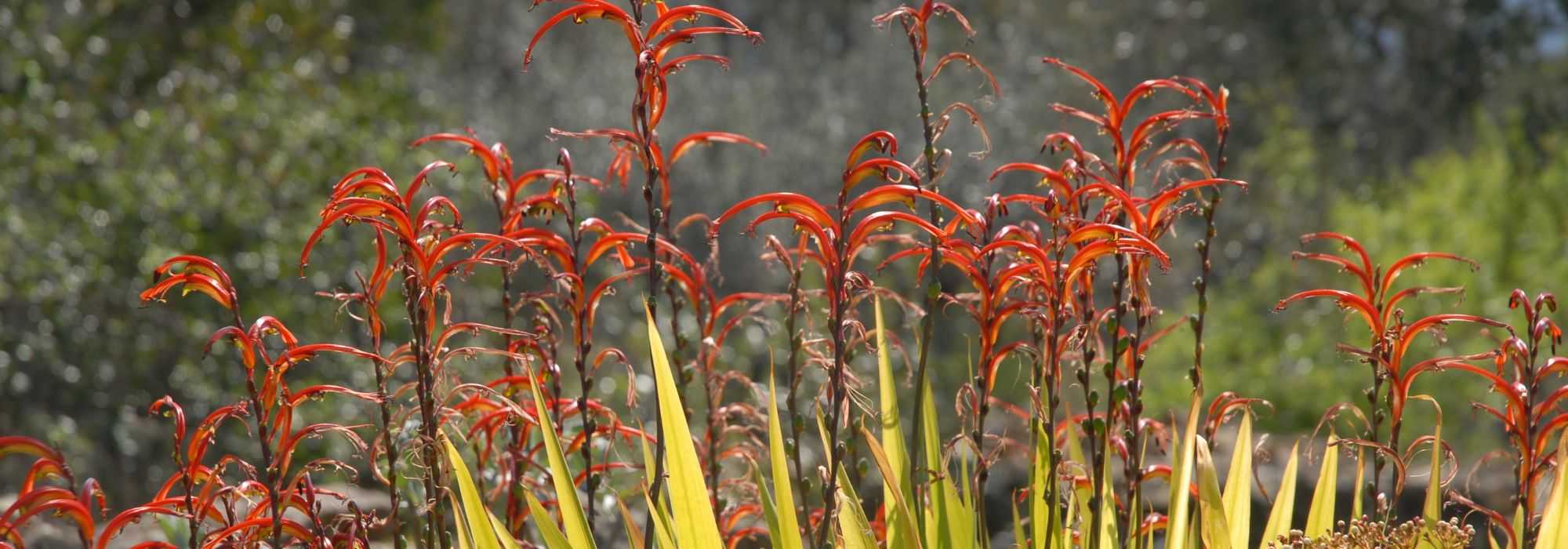
Chasmanthe - Chasmanthe: planting, growing, and caring
Contents
The Chasmanthe in a nutshell
- Chasmanthes are bulbous plants that somewhat resemble Crocosmias
- They flower in spring with tall spikes of tubular red, orange, or yellow flowers
- Not very hardy, they can only be planted in the ground in Mediterranean regions
- In other parts of the country and in Belgium, they should be grown in pots or the bulbs kept dry in winter
- Chasmanthes prefer sun or partial shade and light, well-drained soil
The word from our expert
Chasmanthes, particularly Chasmanthe floribunda, set spring ablaze with their tall, vibrant flowering, which can also be orange or yellow depending on the variety. This is a beautiful bulbous plant (or more precisely, a corm), resembling a large Crocosmia, native to South Africa and suitable for planting in the ground in the Mediterranean basin.
Unfortunately, outside this region, chasmanthes will not survive the winter, as their corms are irreparably damaged at -5°C and they dislike winter moisture. Consequently, in the rest of France and Belgium, they are best grown in pots or dug up in autumn and stored dry over winter, much like Dahlias or gladioli.
Chasmanthes thrive in full sun or partial shade and prefer light, well-drained soil. The soil should remain slightly moist during the growing season (spring) but completely dry in autumn and winter. Needless to say, north of the Loire and in open ground, this is a bit tricky even if we disregard the temperature… But don’t let this deter you from planting chasmanthes, even if you keep them in pots! Their bright, springtime colours are well worth the effort…
Botany and description
Botanical data
- Latin name Chasmante
- Family Iridaceae
- Common name Chasmanthe
- Flowering March-April
- Height 1 m
- Exposure sun or partial shade
- Soil type light, fresh and well-drained soil
- Hardiness -5 °C
The Chasmantes or Chasmanthes belong to the Iridaceae family, like Irises, Gladioli, but especially Crocosmias (Montbretias), to which they are botanically quite similar. The genus Chasmanthe includes only 3 species, all native to South Africa: Chasmanthe aethiopica, Chasmanthe bicolor, and Chasmanthe floribunda. The species Chasmanthe floribunda is the most commonly cultivated in our gardens. This species is nicknamed “Flag of Africa“.
The genus name Chasmanthe comes from Greek: from “chasme” (gaping) and “anthos” (flower).
The storage organ is not a bulb, but a corm. A corm is an underground part of the stem that has swollen and serves as a nutrient storage organ. A corm resembles a bulb quite closely, so Chasmanthes are classified in the garden as “bulb plants”. The corm of Chasmanthes is destroyed at -5° C.
The foliage is deciduous and forms a large clump of linear, erect, green leaves. The foliage dries up in late spring or early summer and disappears completely by late summer. The plant then enters its dormant phase, thus escaping the summer drought. The foliage will only re-emerge in autumn.
Flowering occurs in spring (March-April) and features tall flower spikes over a metre high. These spikes are adorned with tubular flowers arranged in two rows and zigzagging on either side of the stem. The flowers are red, orange, or yellow, depending on the variety (see point: our most beautiful varieties). On each flower, the very long upper petal releases long stamens with purple anthers.
In our region, the flowers are pollinated by insects, but this is not the case in South Africa. In their natural range, the flowers are pollinated by a beautiful passerine bird, the Orange-breasted Sunbird (Anthobaphes violacea). This small, brightly coloured bird has a very fine, curved beak, which allows it to reach the nectar of the flowers and, in the process, pollinate them.
Once pollinated, the flowers give way to capsules containing seeds that can self-sow under favourable conditions. In fact, the species Chasmanthe floribunda has naturalised in southern Australia.
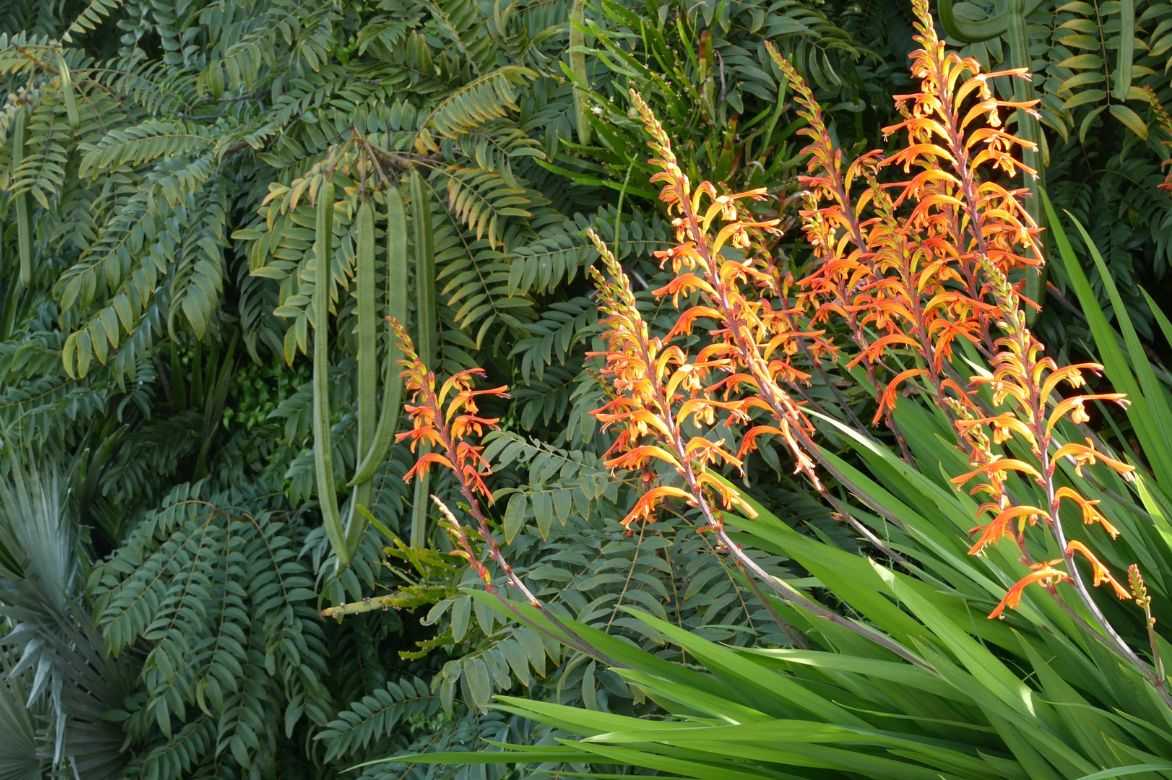
Chasmanthe floribunda
Our most beautiful varieties
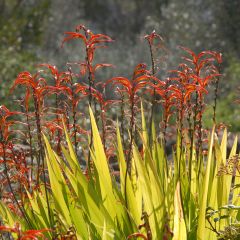
Chasmanthe floribunda
- Flowering time April, May
- Height at maturity 1 m
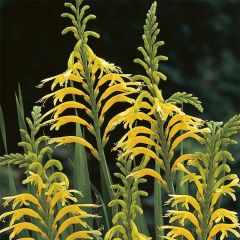
Chasmanthe floribunda Duckittii - African Flag
- Flowering time April, May
- Height at maturity 1 m
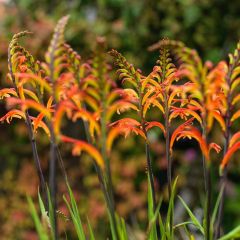
Chasmanthe floribunda Saturnus
- Flowering time April, May
- Height at maturity 1 m
Discover other Chasmanthes
View all →Available in 0 sizes
Available in 1 sizes
Available in 1 sizes
Available in 1 sizes
Planting chasmanthes
Where to plant?
Chasmanthes should only be planted in the ground in mild climates: in Mediterranean regions or along the southern part of the Atlantic coast. Elsewhere, they should only be grown in pots or in a cold greenhouse. The corms of chasmanthes are destroyed at temperatures below -5°C.
Chasmanthes prefer full sun or partial shade and a light, fresh, but well-drained soil.
When to plant?
Chasmanthes are best planted in October or April.
How to plant?
In the ground, in mild climates:
- Loosen the soil to a depth of about 10 centimetres;
- Add well-rotted compost, sand, or even some gravel to lighten the soil and improve drainage;
- Plant your corms (bulbs) at a depth of 9 cm, spacing them at 5 corms per square metre;
- Cover with mulch in winter to protect the corms from severe frosts.
Note: outside Mediterranean regions, chasmanthes can also be grown like gladioli: plant them after the last frosts and lift the corms in autumn to store them in a cool, dry place. Your chasmanthes will then flower in summer.
In pots:
- Choose a terracotta pot, with a drainage hole at the bottom;
- Fill it with a light substrate such as compost for Mediterranean plants;
- Plant your corms (bulbs) at a depth of 10 cm;
- Overwinter the pot in a bright, cool, frost-free location.
Maintenance
In the ground in mild climates (-5°C)
The plant requires little maintenance. It is drought-resistant, but the soil should remain moist during the growing season. If the soil is very dry, do not hesitate to provide water for a beautiful flowering.
You can remove the faded flowers after flowering, in May.
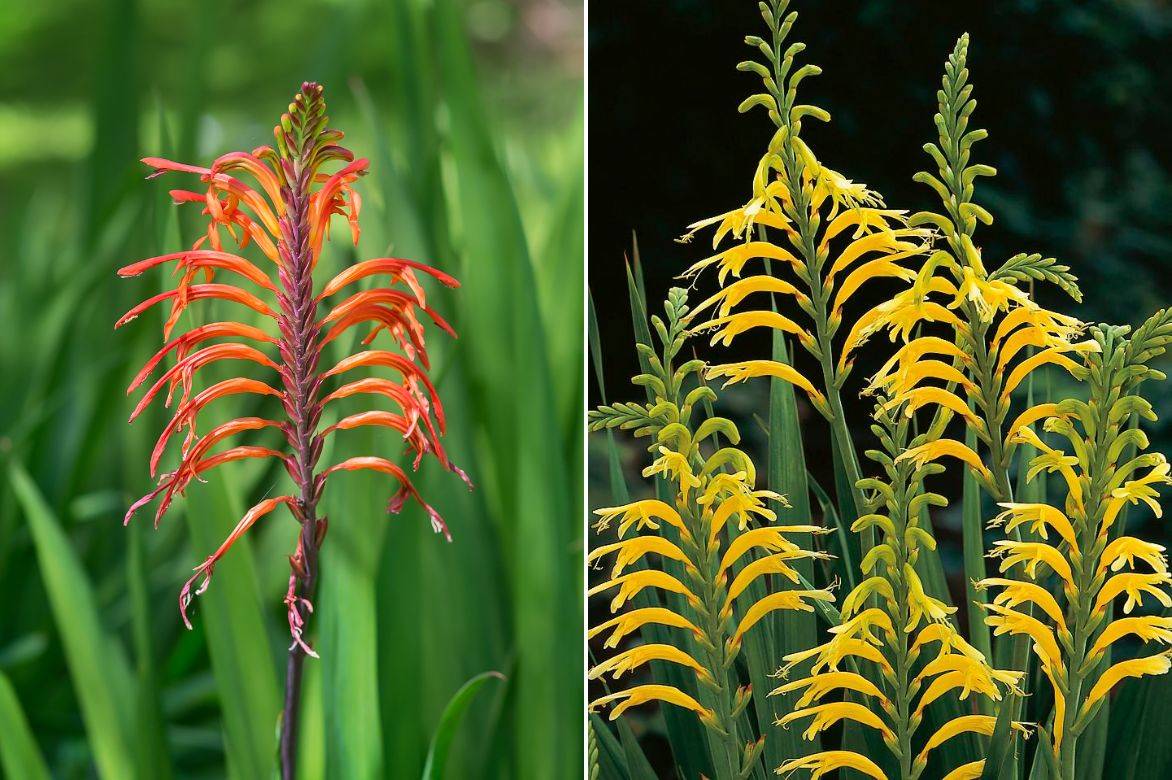
Chasmanthe floribunda and Chasmanthe floribunda ‘Duckittii’ with yellow flowers
In the ground elsewhere
You will need to overwinter the bulbs (as with gladioli or dahlias) in a dry, frost-free place, but not too warm.
In pots
You should bring the pot indoors in winter to a bright, frost-free location. Do not water during the dormant period. Repotting every autumn is necessary.
Diseases and Pests
Aphids can sometimes attack Chasmanthes.
→ Follow Virginie’s expert advice to prevent or control an aphid infestation.
Multiplication
By sowing
If the plant is happy, you may see spontaneous seedlings appear.
Otherwise, harvest your seeds in June-July (in this case, avoid cutting the flower spikes in May, of course). Sow them in autumn in a sheltered spot in a very well-draining substrate (half sowing compost and half river sand) at a temperature of 20°C. Keep the substrate moist until the plant germinates. In spring, when frost is no longer a concern, you can plant them out in the garden. However, you will need to wait 2 years for the plant to flower.
By dividing offsets
Dividing offsets is possible in March. Dig up the stump and collect the new corms around the mother plant. It’s best to leave each group of corms intact rather than separating them: the older ones can then serve as a nutrient reserve to encourage the growth of younger corms. Replant the groups of young corms elsewhere in the garden and water them.
Association
It may seem challenging to pair Chasmanthe floribunda, as these plants bring a strong presence to the garden with the size and colour of their flowers. Nevertheless, we will attempt to combine them with other plants that enjoy the sun, a fresh but well-drained soil, and that flower in March-April. The ideal is to stick to warm tones with a touch of contrasting whimsy: blue!
Let’s start with some Chasmanthe floribunda ‘Saturnus’, with their bright orange flowers. To complement this unusually coloured spring flowering, we’ll rely on reliable bulb varieties with orange flowers: Tulipa fosteriana ‘Orange Emperor’ and Crocus chrysanthus ‘Orange Monarch’.
For contrast, we’ll try a Peruvian Scilla (Scilla peruviana), a tender bulbous flower native to the Mediterranean basin (despite its name), which produces a stunning flowering in the form of a broad, flattened cone, in shades of ultramarine blue to vivid violet-blue.
→ Discover more ideas for pairing with chasmanthes in our advice sheet!

Chasmanthe floribunda ‘Saturnus’, Tulipa fosteriana ‘Orange Emperor’, Scilla peruviana, and Crocus chrysanthus ‘Orange Monarch’
Useful resources
Find our chasmanthes in our online nursery.
- Subscribe!
- Contents































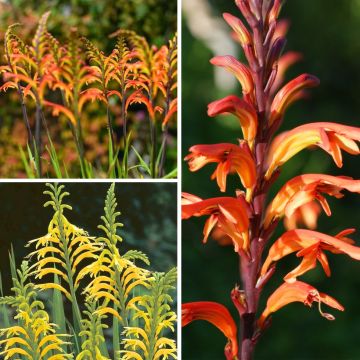



Comments